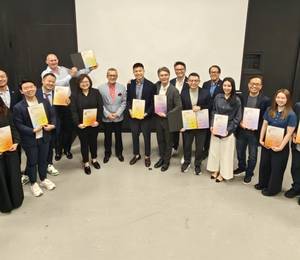Singapore – Minister for Sustainability and the Environment Ms Grace Fu officially launched the “Industry Guidelines for Indoor Air Quality” at a visit to C&W Services, the facilities and engineering arm of global real estate services firm, Cushman & Wakefield on 4 January 2023. The industry guidelines are part of efforts by the Alliance for Action (AfA) on Sustainable Spaces to raise public awareness on the importance of good indoor air quality.
Developed in consultation with industry stakeholders, the guidelines focus on five priority areas that companies should consider: (i) adopt emission limits for products and furnishing indoors, (ii) adopt Singapore standards for good indoor air quality, (iii) acquire certification as an endorsement of their efforts to maintaining good indoor air quality, (iv) implement workplace safety and health guidelines, (v) monitor Indoor Air Quality and implement mitigating measures. The recommendations are aligned to three guiding principles - to regulate, incentivise and to foster collaboration within the industry-public sector.
The AfA on Sustainable Spaces was jointly formed by the Singapore Business Federation (SBF), Singapore Furniture Industries Council (SFIC), and Singapore Green Building Council (SGBC) in November 2021, to bring together stakeholders across different sectors to create and enhance sustainable spaces. Supported by the Building and Construction Authority (BCA) and the National Environment Agency (NEA), the AfA also aims to help solution providers and adopters seize opportunities in the green economy and support the Singapore Green Plan 2030.
During the visit to C&W Services, Minister Grace Fu also engaged more than 40 AfA members and industry stakeholders in a fireside chat on advancing the sustainability agenda, moderated by SBF Council Member Mr Ernie Koh.
Mr Ernie Koh, Council Member, SBF, said, “Good indoor air quality is critical to our health and well-being, given that we spend more than 90 percent of our time indoors. The industry guidelines are an industry-initiated effort by the industry, for the industry. Through the development of these guidelines, the AfA hopes to showcase the best practices for good indoor air quality, and at the same time, bring greater attention to the many sustainable products and offerings by local companies.”
Ms Natalie Craig, Managing Director, C&W Services Singapore said, “Good indoor quality is essential to enhancing productivity and promoting a healthy work environment. Industry guidelines are a meaningful step towards addressing indoor air quality. At C&W Services, we leverage cutting-edge technologies and combine them with the best detection and analytics tools. This means that we can use innovations such as air quality monitors to deliver excellent indoor air quality and our analytics platform to provide actionable insights for stakeholders to make accurate ventilation decisions.’”
Mr Phua Boon Huat, President, SFIC, said, “The timely introduction of the Industry Guidelines for Indoor Air Quality under the AfA is the latest strategy that is in line with the furniture industry’s own Sustainability Blueprint and 2025 Furniture Industry Roadmap. SFIC has committed to the AfA’s Low Formaldehyde Commitment Pledge in April 2022 to supply or adopt low or no formaldehyde products and solutions. These new industry guidelines would mean the public and consumers will be able to enjoy cleaner and greener urban indoor spaces in future. Moving forward, we would like to advocate for industry players to opt for cleaner, safer materials in their offerings and designs. As for the consumers, we hope that these guidelines will encourage and educate them to be able to discern what’s best for their family and the environment.”
Mr Tang Kok Thye, President, SGBC, said, “Green buildings are good for the environment but even better for people with their emphasis on human health and wellbeing. With growing consumer attention on the impact of air quality on health, these guidelines will help to spur concrete action by companies to monitor, track and optimise the health and well-being of our places and spaces for occupants.”











